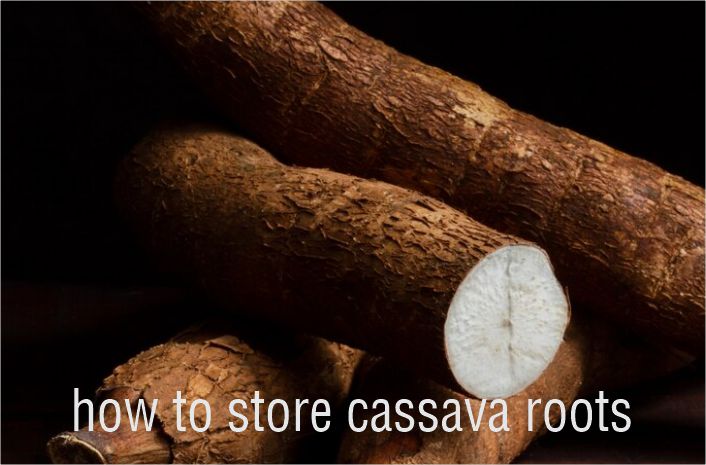Learn how to store cassava root, both fresh and frozen, to maintain its quality and flavor for longer use.
Storing cassava root the right way is key to keeping it fresh and tasty, whether you’re using it right away or saving it for later.
Fresh cassava has a great flavor, but it spoils quickly. If you need to store it longer, freezing is an option, though it may change the texture a bit.
In this guide, you’ll discover simple, effective ways to store both fresh and frozen cassava.
With these methods, you can enjoy its flavor and nutritional benefits anytime you need it, without worrying about spoilage. Ready to keep your cassava in top shape? Let’s dive in!
If you are new to learning about cassava, here is a good place to start.
Table of Contents
- How to Store Cassava Root: A Complete Guide
- Preparing Cassava for Freezing
- Freezing Methods for Cassava Root
- Shelf Life and Usage of Frozen Cassava
- Fresh vs. Frozen Cassava: Pros and Cons
- Conclusion
How to Store Cassava Root: A Complete Guide
Short-Term Storage Techniques
When you buy fresh cassava root, you may want to store it for a few days before using it. For this, proper handling and storage are key.
Fresh, unpeeled cassava should be kept in a cool, dry place. Ideally, you should aim for a temperature range between 20°C and 25°C (68°F to 77°F) to slow the natural degradation process of the root.
Avoid areas with high humidity, as moisture can encourage mold and spoilage. Additionally, never store cassava in direct sunlight.
Sunlight exposure can cause the root to deteriorate faster, and you might find it unusable after a short time. Instead, look for a shaded spot or store the cassava indoors where air circulation is good.
For even better results, store cassava on a dry surface such as a wire rack or wooden shelf. Avoid stacking the roots on top of each other.
Stacking can create pressure points, leading to bruising and a shorter shelf life. It’s also important to check the roots for any signs of spoilage, discoloration or an unpleasant smell, and remove affected ones immediately to prevent them from contaminating others.
Also Read: Growing Cassava in Small Spaces
Refrigeration Methods for Fresh Cassava
If you need to extend the shelf life of fresh cassava for a few extra days, refrigeration is a great option.
The process starts by cleaning the root and removing any dirt. Then, wrap the cassava in a dry paper towel to absorb moisture that can lead to mold growth.
After wrapping it, place the cassava in a perforated plastic bag. The perforations allow for air circulation, helping to prevent excess moisture buildup.
Store the wrapped cassava in the vegetable crisper drawer of your fridge, where the humidity level is controlled.
Under these conditions, fresh cassava can stay fresh for up to a week. Just make sure to check for any signs of spoilage regularly.
Related: How Starch from Cassava Root is Made
Extended Fresh Storage Solutions: Storing Peeled Cassava
If you’ve already peeled the cassava and want to keep it fresh for a longer period, storing it in water is an effective solution.
To do this, place the peeled cassava in an airtight container and cover it with water. This method helps preserve the root’s texture and prevents dehydration.
Make sure to change the water every two days to avoid fermentation, which could ruin the cassava. If the water becomes cloudy, it’s time to replace it.
If stored correctly, peeled cassava in water can last for up to one month, making it a great option for those who want to prepare their cassava in advance.
Recommended: How to Preserve Cassava Stems for Next Farming Season
Preparing Cassava for Freezing
Freezing is an excellent option for long-term storage, but it requires proper preparation to maintain the cassava’s quality.
Start by peeling the root and removing the thick, brown outer skin. Use a sharp knife or vegetable peeler to eliminate any fibrous parts.
Once peeled, cut the cassava into small, even pieces, ideally 1 to 2 inches in length.
Before freezing, blanch the pieces to preserve their color and texture. Blanching involves briefly boiling the cassava in water for about 3 to 5 minutes.
This process kills any enzymes that could lead to spoilage during freezing. After blanching, quickly transfer the cassava into ice water to stop the cooking process.
Once cooled, drain the cassava thoroughly. You want it to be as dry as possible before packing it into freezer bags or containers.
Be sure to remove as much air as possible to prevent freezer burn. If you’re using freezer bags, press out the air before sealing. Properly prepared, frozen cassava can last for several months.
Further Reading: How to Cut Cassava Stems Correctly
Freezing Methods for Cassava Root
When freezing cassava root, follow these steps for the best results:
- Peel and Cut: Start by peeling the cassava and cutting it into uniform pieces.
- Blanch: Boil the cassava pieces for 3 to 5 minutes to kill spoilage-causing enzymes.
- Ice Bath: Immediately transfer the cassava to an ice bath to stop the cooking process.
- Dry Thoroughly: Drain and dry the cassava before freezing.
- Package for Freezing: Use airtight freezer bags or vacuum-sealed containers to store the cassava. Make sure to squeeze out excess air.
- Label and Date: Don’t forget to label the bags with the date to track freshness.
When freezing cassava, aim to use it within 6 to 12 months. While it can last longer, its flavor and texture are best when used within this time frame.
You can cook frozen cassava directly from the freezer or thaw it in the fridge before use, depending on your recipe.
Related: How to Harvest Cassava Roots
Shelf Life and Usage of Frozen Cassava
Frozen cassava offers convenience and a long shelf life. When properly stored, it can maintain its quality for up to six months.
The key to maximizing its storage life is to ensure that the cassava is packed in an airtight container to prevent freezer burn. Once frozen, cassava retains its flavor, texture, and nutrients, but it’s important to handle it correctly.
Thawing Frozen Cassava
Thawing frozen cassava can be done in two ways:
- In the Refrigerator: Place the frozen cassava in the fridge overnight to allow for slow, even thawing. This method preserves the texture best.
- Direct Cooking: For quicker meals, you can cook frozen cassava directly without thawing. This is particularly useful for dishes that involve boiling or steaming.
How to Cook Frozen Cassava
Cooking frozen cassava is simple, though it may require a slightly longer cooking time than fresh cassava.
Boil or steam the frozen pieces, checking the texture as you go. It may take a few extra minutes to achieve the desired softness, but the result will be just as delicious as fresh cassava.
Related: Signs Your Cassava is Ready for Harvest
Fresh vs. Frozen Cassava: Pros and Cons
Fresh Cassava: The Benefits
Fresh cassava is often prized for its superior taste and texture. It has a firm, starchy consistency that works well in various dishes. Plus, fresh cassava is free from preservatives, making it a natural option for those who prefer whole, unprocessed foods.
However, fresh cassava has a relatively short shelf life, and once peeled, it must be used quickly to avoid spoilage. If you don’t plan on using it immediately, it’s better to refrigerate or freeze it to extend its freshness.
Frozen Cassava: The Convenience Factor
Frozen cassava, on the other hand, offers great convenience for long-term storage. Freezing preserves the root for months, which is perfect for bulk buying and meal prep. You can keep it on hand and use it as needed, without worrying about it going bad quickly.
The downside is that freezing cassava can slightly alter its texture, making it softer once thawed.
While this doesn’t affect its flavor or nutritional value, it may not be suitable for all recipes where a firmer texture is required.
Choosing Between Fresh and Frozen Cassava
The choice between fresh and frozen cassava depends on your preferences and cooking habits.
If you plan to use cassava within a few days and want the best texture and flavor, fresh cassava is the way to go.
However, if you need to store cassava for longer periods or prefer the convenience of frozen goods, freezing is a great solution.
Conclusion
In conclusion, both fresh and frozen cassava have their advantages. The key to getting the best results is using the proper storage techniques, whether you’re keeping cassava fresh for a few days or storing it long-term.
By following the steps outlined in this guide, you can ensure that your cassava remains tasty and nutritious, no matter how you choose to store it.

Chimeremeze Emeh is a writer and researcher passionate about Africa’s most transformative root crop—cassava. Through his work at cassavavaluechain.com, he explores the entire cassava industry, from cultivation and processing to its diverse applications in food, health, and industrial use.
He also writes for palmoilpalm.com, where he shares his extensive experience and deep-rooted knowledge of palm oil, covering red palm oil, palm kernel oil, and refined products. His work there reflects his lifelong connection to agriculture and his commitment to promoting sustainable value chains in Africa.
Driven by curiosity and purpose, Chimeremeze aims to shed light on how cassava continues to empower communities, strengthen food systems, and link traditional farming wisdom with modern innovation.

